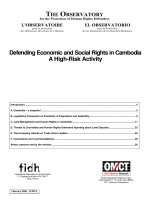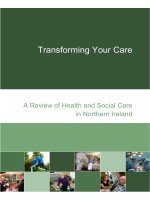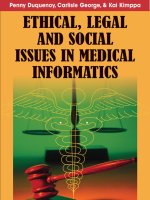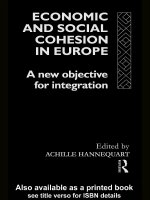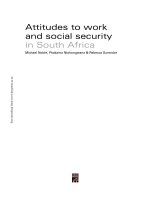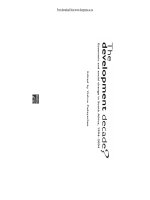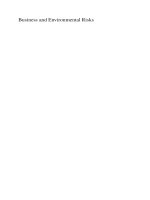business and environmental risks spatial interactions between environmental hazards and social vulnerabilities in ibero-america
Bạn đang xem bản rút gọn của tài liệu. Xem và tải ngay bản đầy đủ của tài liệu tại đây (3.98 MB, 174 trang )
Business and Environmental Risks
Diego A. Vazquez-Brust · José A. Plaza-Úbeda ·
Jerónimo de Burgos-Jiménez · Claudia E. Natenzon
Editors
Business and Environmental
Risks
Spatial Interactions Between Environmental
Hazards and Social Vulnerabilities
in Ibero-America
Foreword by Kjell-Erik Bugge
123
Editors
Dr. Diego A. Vazquez-Brust
The Centre for Business Relationships,
Accountability, Sustainability
and Society (BRASS)
Cardiff University
55, Park Place
Cardiff
Wales
CF10 3AT
U.K.
Dr. José A. Plaza-Úbeda
Department of Business Administration
University of Almeria, Spain
Ctra. Sacramento s/n La Cañada
de S. Urbano
04120 Almería
Spain
Dr. Jerónimo de Burgos-Jiménez
Department of Business Administration
University of Almeria, Spain
Ctra. Sacramento s/n La Cañada
de S. Urbano
04120 Almería
Spain
Prof. Claudia E. Natenzon
Institute of Geography “Romualdo
Ardissone”
Faculty of Philosophy and Letters
University of Buenos Aires
Puan 480 - 4º piso
Buenos Aires 1406
Argentina
natenzon@filo.uba.ar
ISBN 978-94-007-2741-0 e-ISBN 978-94-007-2742-7
DOI 10.1007/978-94-007-2742-7
Springer Dordrecht Heidelberg London New York
Library of Congress Control Number: 2011941278
© Springer Science+Business Media B.V. 2012
No part of this work may be reproduced, stored in a retrieval system, or transmitted in any form or by
any means, electronic, mechanical, photocopying, microfilming, recording or otherwise, without written
permission from the Publisher, with the exception of any material supplied specifically for the purpose
of being entered and executed on a computer system, for exclusive use by the purchaser of the work.
Printed on acid-free paper
Springer is part of Springer Science+Business Media (www.springer.com)
To all those living in ‘hot-spots’ and
suffering the consequences of the problems
outlined in this book. We wish them a
brighter future both socially and
environmentally
To our families and friends
This is Blank Page Integra vi
Foreword
Vulnerability and poverty are real threats to worldwide prosperity, and there is a
need to act now. Fortunately this is exactly what this book does: presenting results
from real life cases and simultaneously providing a methodology that can help us
move forward towards increased awareness, improved understanding of risks, and
effective risk management based on well-informed decision-making.
And this is why I was both honoured and pleased to accept the opportunity to
write this foreword. During the past two decades I have been ‘fighting’ for a more
sustainable development, focusing on how the combination of process management
and decision-support can help stakeholders creating a better future together. My
work has been both in developed and developing countries, and in all cases I have
seen one key success factor: human beings. They create most of the problems, and
they are the ones that have the ability to solve them too.
This brings me to my visit to Buenos Aires last year where not only the beautiful
parks and the nicely revitalized harbour area were visited, but also ‘La Villa de
Retiro’: a massive semi-illegal settlement of marginal dwellers. The contrasts are
so striking between rich and poor, opportunities and threats, and this is not only the
case in Buenos Aires, but in all Latin America.
After having seen the problems with my own eyes, we (the authors and I)
continued the discussion on how a better understanding of real life problems can
contribute to their solution, and I was again impressed by their knowledge but also
in particular by their desire to make a real difference. They not only convinced me
about the importance and urgency of the problems, but they also gave me hope for
the future.
This hope is embedded in the contents of this book, because both challenges and
a workable strategy towards solutions are presented in a coherent way. The partic-
ularly useful perspective, and emphasis of this book, is on the risks related to how
social vulnerability and environmental hazards negatively reinforce each other in
so-called ‘hot-spots’. The methodology for identifying these risks even includes an
attempt to t ake into account cumulative effects of localized environmental hazards
e.g. caused by several small firms. In that respect the authors make a daring, and
necessary, step towards improved inter-disciplinary approaches for addressing real
life challenges. They acknowledge that the richness and complexity of life is much
vii
viii Foreword
more than its individual parts, and, in particular, they focus on how understanding of
the problems provides a basis for effective governability and management of risks.
Policy makers should therefore read this book focusing on how governability
affects performance, and how the understanding of ‘hot-spots’ and GIS can be
used together as a powerful tool for visualizing results and facilitating decision-
making. Scientists should read it, because the methodology suggested represents a
daring attempt to address real life cumulative problems and there is a need for more
scientists to engage in inter-disciplinary science.
Finally, I would like to return to the three issues mentioned initially, increased
awareness, improved understanding of risks, and effective risk management based
on well-informed decision-making. These are interdependent objectives. Effective
risk management builds on understanding, and awareness is an important step
towards support for changes to policy and practice. This is why this book is so
important, because it offers the basis for an integral approach to all three issues!
As the Latin American case studies especially illustrate, (much) more under-
standing of ‘hot-spots’ is definitely needed, but it should be accompanied by, and
embedded in, an approach that focuses on multi-actor involvement. My hope and
strong recommendation for the future is, therefore, that the stakeholders seize this
opportunity: together.
Deventer, The Netherlands Kjell-Erik Bugge
Acknowledgments
First of all we wish to thanks Spanish Agency for International Cooperation and
Development (AECID). Without the grant this research would have not been pos-
sible. We are also immensely indebted to two people for their constant support and
trust. Professor Jose J. Céspedes-Lorente has always been there providing encour-
agement and helpful suggestions while Professor Ken Peattie has given insightful
comments, guidance and advice from the early stages of this research. Again,
without their faith on the project, this book would have not been possible.
Special Thanks as well to Catherine Liston-Heyes and Kjell-Erik Bugge which
made many useful suggestions and gave us valuable feedback and empathy. We
would also like to thanks Rodrigo Lozano for his insights and critical analysis,
Alejandro Martucci for his efforts to map industrial risks in Venezuela and in
particular Clovis Zapata for his ideas for a spin-off of this project focusing on
rural hot-spots in Brazil. We hope we will continue exploring joint avenues for
collaboration in the future.
Finally, many thanks to Miguel Angel Plaza-Ubeda for his invaluable assistance
in a variety of technical emergencies.
ix
This is Blank Page Integra x
Contents
1 Introduction 1
José A. Plaza-Úbeda, Claudia E. Natenzon, Diego A.
Vazquez-Brust, Jerónimo de Burgos-Jiménez, and Julieta Barrenechea
2 Evaluating the Firm’s Environmental Risk:
A Conceptual Framework 15
Diego A. Vazquez-Brust, Claudia E. Natenzon, Jerónimo de
Burgos-Jiménez, José A. Plaza-Úbeda, and Sergio D. López
3 Statistical Information for the Analysis of Social
Vulnerability in Latin America – Comparison with Spain 35
Anabel Calvo, Mariana L. Caspani, Julieta Barrenechea, and
Claudia E. Natenzon
4 Evaluating the Firm’s Environmental Hazardousness: Methodology 53
Sergio D. López and Diego A. Vazquez-Brust
5 The Case of Bolivia 69
Luis Augusto Ballivián-Céspedes, Yolanda Bueno-Cachadiña,
and Sergio D. López
6 The Case of Argentina 91
Claudia E. Natenzon, Diego A. Vazquez-Brust, and Sergio D. López
7 The Case of Spain 117
José A. Plaza-Úbeda, Julieta Barrenechea, Jerónimo de
Burgos-Jiménez, Miguel Pérez-Valls, and Sergio D. López
8 Concluding Remarks 137
Jerónimo de Burgos-Jiménez, Diego A. Vazquez-Brust, José A.
Plaza-Úbeda, and Claudia E. Natenzon
Index 145
xi
This is Blank Page Integra xii
Contributors
Luis Augusto Ballivián-Céspedes Colegio Pestalozzi, Padilla 174, Sucre,
Bolivia,
Julieta Barrenechea Cátedra Sánchez-Mazas UPV/EHU, Universidad del País
Vasco, 72 (20018) San Sebastian, Spain,
Yolanda Bueno-Cachadiña OB Mallas SRL, Av. Jaime Mendoza 1202 A, Sucre,
Bolivia,
Jerónimo de Burgos-Jiménez Department of Business Administration,
University of Almeria, Almeria 04120, Spain,
Anabel Calvo Faculty of Philosophy and Letters, Institute of Geography
“Romualdo Ardissone”, University of Buenos Aires, Buenos Aires 1406,
Argentina,
Mariana L. Caspani Department of Geography, Faculty of Philosophy and
Letters, University of Buenos Aires, Buenos Aires 1406, Argentina,
Sergio D. López Unidad de Coordinación de Programas y Proyectos con
Financiamiento Externo: Programa de Infraestructura Hídrica de las Provincias del
Norte Grande, Ministerio de Planificación Federal, Inversión Pública y Servicios,
Av. Roque Saenz Peña 938, Piso 6, CABA CP 1035,
Claudia E. Natenzon Faculty of Philosophy and Letters, Institute of Geography
“Romualdo Ardissone”, University of Buenos Aires, Buenos Aires 1406,
Argentina, natenzon@filo.uba.ar
Miguel Pérez-Valls Department of Business Administration, University of
Almeria, Almeria 04120, Spain,
José A. Plaza-Úbeda Department of Business Administration, University of
Almeria, Almeria 04120, Spain,
Diego A. Vazquez-Brust The Centre for Business Relationships, Accountability,
Sustainability and Society (BRASS), Cardiff University, Cardiff Wales CF10 3AT,
UK,
xiii
This is Blank Page Integra xiv
List of Acronyms
3D Tridimensional
AECID Spanish Agency of International Cooperation for
Development
Agencia Española de Cooperación Internacional para el
Desarrollo
AL Latin America
América Latina
BRASS The Economic and Social Sciences Research Council Centre
for Business Relationships Accountability and Society at
Cardiff University
CABA Autonomous City of Buenos Aires
Ciudad Autónoma de Buenos Aires
CBI Confederation of British Industry
CCAA Autonomous communities of Spain
Comunidades Autónomas de España
EU (CE) European Commission
CLACSO Latinoamerican Council of Social Sciences
Consejo Latinoamericano de Ciencias Sociales
CMDSN National Social Minimum Data Sets
Conjunto mínimo de datos sociales nacionales
CSR (RSE) Corporate Social Responsibility
DAC (CAD) Development Assistance Committee, OECD
EAGGF (FEOGA) European Agricultural Guidance and Guarantee Fund
ECHP (PHOGUE) European Community Household Panel
ECLAC (CEPAL) Economic Commission for Latin America and the Caribbean
EPA Environmental Protection Agency USA
ERDF (FEDER) European Regional Development Fund
ESCB (SEBC) European System of Central Banks
ESRC The Economic and Social Sciences Research Council UK
ESS (SEE) European Statistical System
EU (UE) European Union
Eurostat Statistical Office of the European Communities
xv
xvi List of Acronyms
FLACSO Latin American Faculty of Social Sciences – Buenos Aires
Facultad Latinoamericana de Ciencias Sociales
FTAA (ALCA) Free Trade Area of the Americas
IDB (BID) Inter American Development Bank
FIFG (IFOP) Financial Instrument for Fishing Guidance
GIS (SIG) Geographic Information System
IHD (IDH) Human Development Index
IMF (FMI) International Monetary Fund
INDEC Statistical office of Argentina
Instituto Nacional de Estadística y Censos
INE Acronym of the Statistical Office of Bolivia and also of
Spain
Instituto Nacional de Estadística
IP Index of Industrial Hazardousness (perilousness)
IR Index of Evaluated Risk
ISDR International Strategy for Disaster Reduction
ISO International Organization for Standardization
ISV Index of Social Vulnerability
LCS Living Conditions Survey
Encuesta de Condiciones de Vida
LEC (NCA) Level of Environmental Complexity
Nivel de Complejidad Ambiental
m.a.s.l meters above sea level
MABA (AMBA) Metropolitan Area of Buenos Aires
Area Metropolitana del Gran Buenos Aires
NGO (ONG) Non Governmental Organization
OAS (OEA) Organization of American States
OECD (OCDE) Organization for Economic Co-operation and Development
PAHO (OPS) Pan American Health Organization, UN
PIRNA Natural Resources and Environment Research Programme
of Argentina
Programa de Investigaciones en Recursos Naturales y
Ambiente
PL (LP) Poverty Line
RAMINP Regulation on disturbing, unhealthy, toxic and dangerous
activities
Reglamento de actividades molestas, insalubres, nocivas y
peligrosas
SABI Database of Spanish and Portuguese Companies
Base de datos de Empresas Españolas y Portuguesas
SEN National Statistical System
Sistema Estadístico Nacional
SIGBI Soroptimist International Great Britain and Ireland
SME (PyME) Small and Medium Entreprises
UBA University of Buenos Aires
List of Acronyms xvii
UBN (NBI) Unsatisfied Basic Needs
Necesidades Basicas Insatisfechas
UDAPE Social and Economic Policy Analysis Unit Bolivia
Unidad de Análisis de Políticas Sociales y Económicas
UN (ONU) United Nations
UNDP (PNUD) United Nations Development Programme
UNFPA United Nations Population Fund
US SIC United States Standard Industrial Classification System
USA United States of America
WB (BM) World Bank
WHO (OMS) Organización Mundial de la SaludWorld Health
Organization
WTO (OMC) World Trade Organization
This is Blank Page Integra xviii
List of Figures
Fig. 1.1 Territory size by Iberoamerican countries (km
2
) 7
Fig. 1.2 Population by Iberoamerican countries (millions of
inhabitants) 8
Fig. 1.3 GDP per inhabitant (dollars) . 8
Fig. 1.4 GDP by Iberoamerican country (million dollars) 9
Fig. 2.1 Conceptual model: dimensions of risk 17
Fig. 4.1 Evaluated hazard (EH) as a function of the distance
from the industrial site 58
Fig. 4.2 Radius of influence of hazard (R) as a function of
maximumEH 58
Fig. 4.3 Cumulative hazards at a given point calculated by
totalling the impact of each industry as a function of its
distance from that point . . . 59
Fig. 4.4 3-D image of the bell of the kernel density function . . 60
Fig. 4.5 Comparison of the values given by the kernel and linear
functions 61
Fig. 4.6 Kernel function applied to a single point and the sum of
theeffectsofseveralpoints 62
Fig. 4.7 The effect of radius R on the surfaces, given the same
initial points 62
Fig. 4.8 Density function based on the distance from the point
and the category, adjusted in order that q = 1atR = 0 64
Fig. 5.1 Map of industrial hazardousness for the departmental
capitalsofBolivia 77
Fig. 5.2 Index of industrial hazardousness (IP) for the
departmental capitals of Bolivia 78
Fig. 5.3 Map of social vulnerability for the departmental capitals
ofBolivia 78
Fig. 5.4 Index of social vulnerability (IVS) for the departmental
capitalsofBolivia 79
Fig. 5.5 Map of combined risk for the departmental capitals of
Bolivia 80
xix
xx List of Figures
Fig. 5.6 Index of combined risk for the departmental capitals of
Bolivia 80
Fig. 5.7 Map of industrial hazardousness for Santa Cruz de La
Sierra 82
Fig. 5.8 Map of industrial hazardousness for Sucre . . . 83
Fig. 5.9 Map of social vulnerability for Sucre . 85
Fig. 5.10 Map of social vulnerability for Santa Cruz de la Sierra . 86
Fig. 5.11 Map of combined risk for Sucre 87
Fig. 5.12 Map of combined risk for Santa Cruz de la Sierra . . . 88
Fig. 6.1 Map of industrial hazardousness per partido/department
inArgentina 102
Fig. 6.2 Map of social vulnerability in Argentina by department/partido 105
Fig. 6.3 Map of evaluated risk in Argentina by departments/partidos . . 107
Fig. 6.4 Map of location of industrial activities that generate
hazard . . 110
Fig. 6.5 Map of industrial hazardousness in the metropolitan
area of Buenos Aires 111
Fig. 6.6 Map of social vulnerability in the metropolitan area of
Buenos Aires by census unit ( block groups) . . . 112
Fig. 6.7 Map of evaluated risk in the metropolitan area of
Buenos Aires by census unit (block group) . . . 114
Fig. 7.1 Map of environmental hazardousness in Spain by municipalities 121
Fig. 7.2 Index of social vulnerability in Spain by municipalities . 125
Fig. 7.3 Map of evaluated risk in Spain by municipalities 128
Fig. 7.4a Map of social vulnerability in Madrid by census unit . . 130
Fig. 7.4b Map of social vulnerability in Seville by census unit . . 130
Fig. 7.5a Map of industrial hazardousness in Madrid . . . 131
Fig. 7.5b Map of industrial hazardousness in Seville . . . 131
Fig. 7.6a Map of evaluated risk in Madrid by census unit . 132
Fig. 7.6b Maps of evaluated risk (IR) in Seville by census unit . . 132
List of Tables
Table 1.1 Cross-country data . 7
Table 2.1 Evaluated industrial risk: the combination of
hazardousness index with vulnerability index . . 22
Table 2.2 Ranges of evaluated industrial risk . . 23
Table 2.3 Poverty and environmental deterioration in
Latin-America 24
Table3.1 Listofselectedindicators 41
Table 3.2 Results of the compilation and selection of indicators
for Latin America and the Caribbean . 44
Table 3.3 Dimensions, variables and indicators for Argentina and
Spain . . . 51
Table 4.1 Values of R adopted depending on the category . 63
Table4.2 Weightingfactors 63
Table 5.1 General data on the departments of Bolivia . . . 70
Table 5.2 Number of firms per department . . . 76
Table 5.3 Environmental Hazard Contribution by industrial sector
in Sucre . 81
Table 5.4 Environmental Hazardousness Contribution by
industrial sector in Santa Cruz de la Sierra . . . 81
Table 6.1 Annual emission factors per industrial sector
(tonnes/employee) . 97
Table 6.2 Index of industrial hazardousness (IP): ranges and
frequencies 97
Table 6.3 Radius of influence of the hazardousness of an industry 99
Table 6.4 Social vulnerability in Argentina: indicators used . . . 100
Table 6.5 Index of Social Vulnerability (ISV): ranges and
frequencies 100
Table 6.6 Industrial emissions of contaminant particles in
Argentina 101
Table 6.7 Departments with high and very high Index of Industrial
Hazardousness (IH) 104
Table 6.8 Departments with higher Index of social vulnerability
(ISV) 106
xxi
xxii List of Tables
Table 7.1 Municipalities and resident population according to
levelsofIP 122
Table 7.2 Spanish municipalities with high or very high IH and
the population exposed . . . 122
Table 7.3 Dimensions and indicators of social vulnerability in
Spain . . . 123
Table 7.4 Spanish municipalities with very high ISV . . . 125
Table 7.5 Municipalities and resident population according to
levelsofISV 127
Table 7.6 Municipalities and resident population according to
levelsofIR 128
Table 7.7 Descriptive data of the municipalities analysed on the
scale of census units 129
About the Contributing Editors
Jerónimo de Burgos-Jiménez, is a lecturer in Business Organization at the
Universidad de Almería. He specializes in Operations Management, environmen-
tal management and stakeholders. He has published several works that focus on
firms’ environmental management and production management in different interna-
tional journals such as Omega, Scandinavian Journal of Management, International
Journal of Operation and Production Management, Services Industries Journal,
Journal of Business Ethics or Business Strategy and the Environment. In the
research line of the present work he has written chapters for other international
books, as well as contributing to congresses and publishing articles in related
scientific journals.
Claudia E. Natenzon Geographer, graduated with honours in 1975 from the Faculty
of Philosophy and Artsat the Universidad de Buenos Aires. Doctor cum laude in
Geography from the Universidad de Sevilla, España (2000). She is a lecturer at the
Faculty of Geography and Arts, UBA. As a researcher at the Geography Institute
of that Faculty since 1988 she has directed the Research Program on Natural
Resources and the Environment Recursos Naturales y Ambiente-PIRNA. She has
specialized in issues of environmental risk, particularly the diagnosis of social vul-
nerability and its relationship with catastrophes. In recent years she has applied
this knowledge to projects linked to social vulnerability related to climate dynam-
ics, with national (UBA, Agencia, CONICET) and international financing (OEA,
PNUD, PNUMA, GEF, NSF). In the Argentinian Headquarters of FLACSO –
Latin American Faculty of Social Sciences – she has participated in the Planning
and Associated Management Program as an associate researcher and postgraduate
lecturer since 1988. She has worked for national public organisms (DNOA, APN,
CFI, CONICET, Civil Defence, DNCC) and international ones (FAO, Politécnico
de Milán, ALADI, BM, PNUD, GEF).
José A. Plaza-Úbeda, is a lecturer and Doctor in the Area of Business Organization
at the Universidad de Almería, specializing in stakeholder management and firm
environmental management. He presented his thesis on stakeholder integration in
firms in 2005 and had previously published articles related to stakeholder man-
agement in international journals such as Journal of Business Ethics and Business
xxiii
xxiv About the Contributing Editors
Strategy and the Environment. He has been the Spanish coordinator of the project
financed by the Agencia Española de Cooperación y Desarrollo that has given rise
to the present work. In the line of research of the present work, he has previously
contributed chapters in international books, as well as participating in congresses
and publishing articles in related scientific journals.
Diego A. Vazquez-Brust Civil Engineer, MBA and Doctor in Economics
and Business from Royal Holloway, University of London (United Kingdom).
Administration manager of environmental projects in the province of Buenos Aires
(1997–2002); consultant on issues relating the firm and the environment for inter-
national public organizations (IDB, PNUD, WAG) and private ones (YKK.SA,
Kirin SA.). Since 2007 he has been Research Manager at BRASS (Cardiff, UK)
where he coordinates research projects on Poverty, Vulnerability and Industrial
Risk; and Corporate social responsibility in the mining industry. He has lectured
Global Economy at Royal Holloway, University of London since 2006. Since 2009
he is one of the global coordinators of GIN (Greening of Industry Network) – an
international network which promotes the integration of environmental issues in
firms, government and academia. His recent work include the book ‘Collaboration
Facilitating Sustainable Innovation through Collaboration’ (Springer, 2010) with
Sarkis & Cordeiro and articles on environmental risk and social responsibility in
Latin America (Journal of Environmental Management and Journal of Business
Ethics).
About the Contributors
Luis Augusto Ballivián-Céspedes Chemical Engineer, Universidad Mayor, Real
y Pontificia de San Francisco Xavier de Chuquisaca, Bolivia. Specialist in
the Educational Direction of Innovation, UNESCO – Universidad Privada del
Valle, Bolivia. Specialist in Management of Production, Quality and Technology,
Universidad Politécnica de Madrid, Spain. Master in Higher Education –
Universidad Andina Simón Bolívar, Bolivia. Master in Communication and
Educational Technologies – Instituto Latinoamericano de la Comunicación
Educativa, México – Universidad Andina Simón Bolívar, Bolivia. Undergraduate
and postgraduate lecturer at Universidad del Valle and Universidad Andina Simón
Bolívar. President of the Educational Society Juan Enrique Pestalozzi.
Julieta Barrenechea Sociologist (UBA, 1994). Diploma of Advanced Studies
in Science and Technology Management from the Universidad del País Vasco
(UPV/EHU), 2007. Associate researcher with PIRNA – Natural Resources and
Environment Research Program – (UBA) and member of the Area of Research and
Management of Science, Technology and Innovation Networks Cátedra Sánchez-
Mazas UPV/EHU. She has been a research grant fellow at CONICET (National
Council for Scientific and Technical Research, Argentina) and technical advisor to
the Presidency of the Commission for Science and Technology of the Chamber
of Representatives of the Nation of Argentina. She has conducted research into
management and social communication of technological risks, methodologies of
measurement and analysis of social vulnerability to risk in nationally funded
projects (CONICET, UBACYT, ANPCyT) and international ones (GEF, CIDA). At
present she is carrying out research and projects of public policies linked to new
patterns of scientific activity, assessment and management networks of knowledge
based on the quality of relations, the development of competences for collabora-
tive work and governance financed by the Basque Government, Diputación Foral de
Gipuzkoa and FECyT Spain.
Yolanda Bueno-Cachadiña Yolanda earned a degree in Industrial Engineering
with specialization in Electronics from the University of Extremadura. She fur-
ther obtained a degree in Management from the same university before moving
to Bolivia where she completed postgraduate studies in Business Administration
xxv
